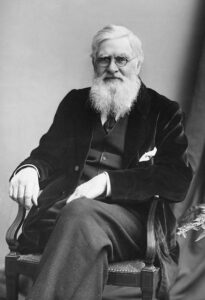Home » Collections showcase » Alfred Russel Wallace’s birds of paradise
Alfred Russel Wallace (1823 – 1913) spent a lot of time outdoors during his first career as a surveyor. He grew fascinated by nature, and studying plants and animals became his life’s work. He developed ideas about evolution at the same time as Charles Darwin (1809 – 1882).
Wallace spent about 20 years on expeditions to test his ideas about evolution. He finished his theories while he was exploring the Malaysian Islands between 1854 and 1862.
On Wallace’s trips to the Malaysian Islands he collected over 8,000 bird specimens. Studying the collection helped him develop theories on evolution.
All those expeditions were expensive. Wallace funded them by catching and killing exotic specimens that he sent home to sell to collectors. Later in life he became troubled by the effects of this kind of destructive behaviour, and he worried that others would ruin the tropical forests he had previously explored.
The Birds of Paradise provide fascinating connections to the curriculum, particularly for Key Stage 2 Science, where students learn about adaptation and natural selection.
As well as Key Stage 3 History, where students can examine the historical debates surrounding the theory of evolution. A debate could involve conflicting perspectives, with some rooted in religious beliefs and others grounded in scientific evidence.
After his travel Wallace moved to Dorset in his sixties and was made a honorary member of Dorset Natural History and Antiquarian Field Club in 1909. Wallace later died in 1913 and was buried in Broadstone, Dorset.

| Cookie | Duration | Description |
|---|---|---|
| cookielawinfo-checkbox-analytics | 11 months | This cookie is set by GDPR Cookie Consent plugin. The cookie is used to store the user consent for the cookies in the category "Analytics". |
| cookielawinfo-checkbox-functional | 11 months | The cookie is set by GDPR cookie consent to record the user consent for the cookies in the category "Functional". |
| cookielawinfo-checkbox-necessary | 11 months | This cookie is set by GDPR Cookie Consent plugin. The cookies is used to store the user consent for the cookies in the category "Necessary". |
| cookielawinfo-checkbox-others | 11 months | This cookie is set by GDPR Cookie Consent plugin. The cookie is used to store the user consent for the cookies in the category "Other. |
| cookielawinfo-checkbox-performance | 11 months | This cookie is set by GDPR Cookie Consent plugin. The cookie is used to store the user consent for the cookies in the category "Performance". |
| viewed_cookie_policy | 11 months | The cookie is set by the GDPR Cookie Consent plugin and is used to store whether or not user has consented to the use of cookies. It does not store any personal data. |

Males great bustards perform spectacular courtship displays, gathering at a ‘lek’ or small display ground to try to impress the females.
The great bustard has a dignified slow walk but tends to run when disturbed, rather than fly.
The hen-bird on display at The Salisbury Museum was one of the last great bustards to be eaten in the town!